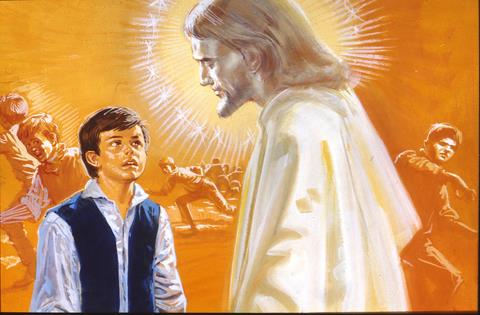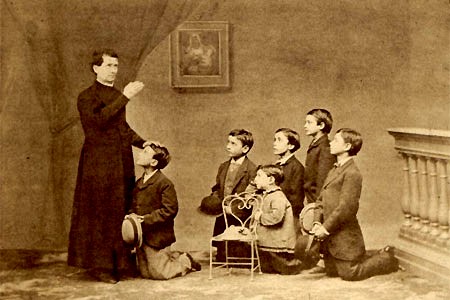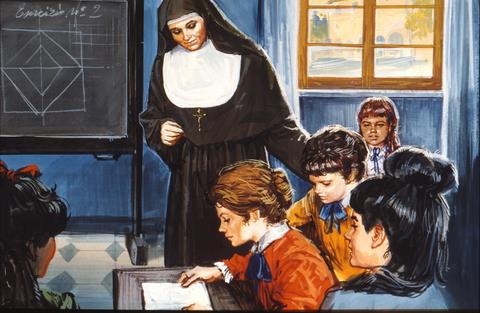Salesian Sisters of St. John Bosco

Both our Founder and our Co-Founder are saints!
St. John Bosco
Saint John Melchior Bosco was a man of bold courage; although his contemporaries tended to think him excessively outspoken and brash. Fortunately the Lord does not judge by the world’s standards, and St John Bosco, or Don Bosco as he is more fondly know, was just the instrument which God chose to use to found a religious family dedicated not only to helping and educating the young and the disadvantaged, but to journeying with them and sharing in their lives in a most familial way.
Born on August 16, 1815, in the small Italian hamlet of Castelnuovo d’Asti. he was the pride and joy of his parents Margaret and Francis. His father died when he still a toddler and his mother was forced to work long hours in order to support them. She would later remarry giving him two brothers, Anthony and Joseph.
As a child he worked as a shepherd, watching over his family’s sleep. In his free time he practiced magic tricks and jugglin and amazed his friends with his ability to walk tight ropes and to do acrobatics.
At nine he had a dream which was an indication of his future work. Don Bosco himself recounts
When I was about nine years old I had a dream that left a profound impression on me for the rest of my life. I dreamed that I was near my home, in a very large playing field where a crowd of children were having fun. Some were laughing, others were playing and not a few were cursing. I was so shocked at their language that I jumped into their midst, swinging wildly and shouting at them to stop.
At that moment a Man appeared, nobly attired, with a manly and imposing bearing. He was clad with a white flowing mantle and his face radiated such light that I could not look directly at him. He called me by name and told me to place myself as leader over those boys, adding the words, “You will have to win these friends of your not with blows, but with gentleness and kindness. So begin right now to show them that sin is ugly and virtue beautiful.”
Confused and afraid, I replied that I was only a boy and unable to talk to these youngsters about religion. At that moment the fighting, shouting and cursing stopped and the crowd of boys gathered about the Man who was now talking. Almost unconsciously I asked, “But how can you order me to do something that looks so impossible?”
“What seems to impossible you must achieve by being obedient and by acquiring knowledge.”
“But where? How?”
“I will give you a Teacher under whose guidance you will learn and without whose help all knowledge becomes foolishness.”
“But who are you?”
“I am the Son of Her whom your mother has taught you to greet three times a day.”
“My mother told me not to talk to people I don’t know, unless she gives me permission. So, please tell me your name.”
“Ask your mother.”
At that moment I saw beside him a Lady of majestic appearance, wearing a beautiful mantle glowing as if bedecked with stars. She saw my confusion mount; so she beckoned me to her. Taking my hand with great kindness she said,
“Look!”
I did so. All the children had vanished. In their place I saw many animals: goats, dogs, cats, bears and a variety of others.
“This is your field, this is where you must work.”, the Lady told me.
“Make yourself humble, steadfast and strong. And what you will see happen to these animals you will have to do for my children.”
I looked again; the wild animals had turned into as many lambs, gentle, gamboling lambs, bleating a welcome for that Man and Lady.
At this point of my dream I started to cry and begged the Lady to explain what it had meant because I was so utterly confused. She then placed her hand on my head and said, “In due time everything will be clear to you.”
After she had spoken these words, some noise awoke me; everything had vanished. I was completely bewildered. Somehow my hands still seemed to ache and my cheeks still stung because of all the fighting. Moreover, my conversation with that Man and Lady so disturbed my mind that I was unable to sleep any longer that night.
In the morning, I could barely wait to tell about my dream. When my brothers heard it, they burst out laughing. I then told my mother and grandmother. Each one who heard it gave a different interpretation. My brother Joseph said, “You’re going to become a shepherd and take care of goats, sheep and livestock.”
My mother’s comment was, “Who knows? Maybe you will become a priest.”
Dryly, Anthony muttered, “You might become the leader of a gang of robbers.”
But my very religious, illiterate grandmother had the last word, “You mustn’t pay any attention to dreams.”
The little John Bosco understood his calling though, as did his mother; he would have to go to school to be able to become a priest. Father Calosso, his parish priest, recognized his exceptional intelligence and began tutoring him in Latin.
Anthony, his other brother, found it difficult to watch John go to school everyday while he, the eldest, went to labor in the fields all day long. His feelings turned into a deep resentment and eventually it became impossible for them to be able to live together peacefully. Margaret knew that this mean that John had to leave if he was to have any chance of continuing his education.
Margaret knew a family that owned a farm that was in need of a farm hand, so with some food and clothing, and his precious school books bundled under his arm, John headed to the Moglia farm where he obtained steady work.
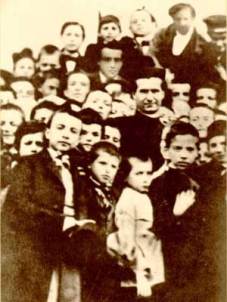 In 1830 his beloved friend and teacher, Fr Calosso, died. As a result John had to return home. Margaret, in order to keep the peace, divided up the farm and gave Anthony his own share. For his part, John would walk three miles each way to school, and labored in different trades.
In 1830 his beloved friend and teacher, Fr Calosso, died. As a result John had to return home. Margaret, in order to keep the peace, divided up the farm and gave Anthony his own share. For his part, John would walk three miles each way to school, and labored in different trades.
God was preparing little John Bosco to be a future teacher of the young, so even though he held many jobs such as an assistant in a blacksmith shop, a cobbler shop, and a tailor shop and worked as a waiter – jobs which would seem pointless in the life of a priest – he was learning so that he could share his knowledge with other.
The hardship and poverty of this time period cannot be enough emphasized. It was a time when child labor was common and abusive. John lived under a flight of stairs at one point, studying his school books at night after an exhausting day’s work using dim candle light. His shoes were worn, his meals poor, but he made many friends and studying was a luxury many children did not have.
With the support of his spiritual director and friend, St Joseph Cafasso, at the age of twenty John Bosco entered the seminary. He was noted for his piety, cheerfulness, and generous heart. Finally, after six additional years of study, on June 5, 1841 John Bosco finally became a priest at the hands of the bishop of Turin, and could finally be called by the Italian title “Don”.
Don Bosco celebrated his first Mass in the church of St Francis of Assisi in Turin, a place where he would often offer Mass after that. It was there that on December 8, 1841 he met a young and spindly Bartholomew Garelli, a local homeless boy.
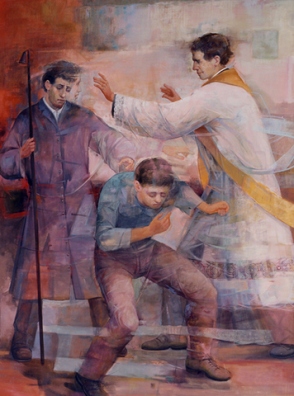 Garelli had wandered into the sacristy seeking anything but religion. It was freezing out and he needed some warmth! The sacristan chased him out, but Don Bosco reprimanded the man and had him bring the boy, who was now terrified, back to him. Don Bosco’s kindness won the teenager over and soon he brought more friends to Don Bosco.
Garelli had wandered into the sacristy seeking anything but religion. It was freezing out and he needed some warmth! The sacristan chased him out, but Don Bosco reprimanded the man and had him bring the boy, who was now terrified, back to him. Don Bosco’s kindness won the teenager over and soon he brought more friends to Don Bosco.
Don Bosco ended up offering Garelli and his friends food, games, and catechism lessons. They were attracted by his obvious love for them, paired with his talent for magic tricks and juggling. Their numbers grew so great that Don Bosco had to rent field after field as they often outgrew them or were kicked out for being too noisy; it became a “Wandering Oratory” as Don Bosco called it.
Soon others like Don Borel were attracted to his work with the young men who could be found begging, gambling, and loitering on every street corner of Turin. The government saw the boys as a nuisance at best and a threat to the order of the city at worst, and did nothing to help them. Young men who were lucky enough to find work labored long hours, in terrible conditions, and for little pay. Sickness and disease were rampant, often augmented by malnutrition. Their clothing was insufficient, their shoes most likely stolen and falling apart. Not only were most of them homeless, most of them were orphans coming as from as far as France and Sweden looking for work; they had little hope, no money, and no family.
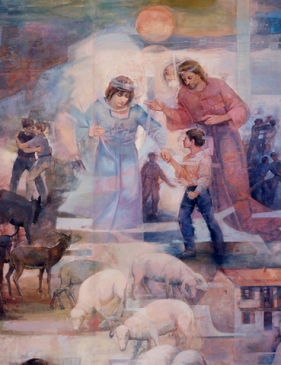 Don Bosco realized that there, with those young men, was the answer to his dream as a nine year old boy. If only he could win their trust he could instill in them a sense of faith in God, but they needed not only spiritual bread, but literal bread for their stomachs. They were starving and he needed funds to take care of them. Don Bosco began to beg, knock on doors, preach, and plead with the people of Turin to help him to care for all of these boys.
Don Bosco realized that there, with those young men, was the answer to his dream as a nine year old boy. If only he could win their trust he could instill in them a sense of faith in God, but they needed not only spiritual bread, but literal bread for their stomachs. They were starving and he needed funds to take care of them. Don Bosco began to beg, knock on doors, preach, and plead with the people of Turin to help him to care for all of these boys.
Soon other helpers were added to Don Borel and Don Cafasso continued to encourage and guide him in his work. God always provided what Don Bosco needed to help the boys, even if it sometimes required a miracle (like multiplying food or money). Although his faith was extraordinary, Don Bosco always contended that he did not have enough. Workshops were opened and Don Bosco was able to pass on the trades which he had learned to his boys.
Don Bosco’s work with the young grew, and through many trials, assassination attempts (as some thought him a revolutionary opening workshops and not making the boys work more than eight hours a day; surely he was training an army to overthrow the government!), and frustrations, he was able to obtain a tract of land and a little shed to build a chapel in on the Pinardi farm. This soon became the motherhouse of the Salesian order, as the Oratory grew into a boarding and day school.
The name “Salesian” was first used in a conference with his helpers by Don Bosco on January 26th of the Marian year, 1854. During that year Pope Pius IX would declare the dogma of the Immaculate Conception and Saint Dominic Savio would join the Oratory.
During 1855 Don Bosco saw great growth in the work of his Salesians. The cleric Blessed Michael Rua professed his first vows in Don Bosco’s presence, and Father Pestarino founded the Daughters of Mary Immaculate in Mornese, who would later form the first Salesian Sisters. With the assistance of St Mary Mazzarello the Salesian Sisters professed their first vows in 1872.
After many small steps and great risks, the Salesian Congregation was finally formally approved by the Holy See on April 3, 1874. The remainder of Don Bosco’s life consisted of opening a house in Nice, France, sending missionaries to South America, and traveling to raise money for the building of the Basillica of Mary Help of Christians in Turin and of the Basillica of the Sacred Heart in Rome. The Salesian Family expanded quickly and in 1876 the association of his first helpers, the Salesians Cooperators, was finally approved.
In January 1888 Don Bosco took to bed with a fever. The doctors said that his body was completely exhausted. His spiritual children gathered around him, and his last words were ones that assured his Salesians that Mary Help of Christians was with them in their work. He admonished them to always love one another and to live in the Salesian Family Spirit.
Don Bosco died on January 31, 1888 and left behind 773 Salesian priests and brothers and 393 Daughters of Mary Help of Christians. He was canonized on April 1, 1934 by Pope Pius XI.
St. Maria Domenica Mazzarello
St Mary Domenica Mazzarello was born in Mornese, Alessandria, Italy on May 9, 1837 to hardworking parents. Her family was not of abundant means, so each day brought with it long days in the vineyards, carefully tending to the delicate vines in the glaring sun.
Mary Mazzarello was know for her cheerful spirit and willingness to help others, even at a cost to herself. She was not without a temper, though! Her quick wit could often turn sour when vexed, and controlling her temper was something, like Don Bosco, she would have to work at all of her life.
When she was fifteen she the Association of the Daughters of Mary Immaculate, run by her parish priest, Father Pestarino; it was a precursor to the founding of the Salesian Sisters.
The Daughters were known for their charitable works and Mary soon set herself apart for her sound judgment, dedication, joy, and love of the young. Wherever she want the village children were drawn to her like a magnet, eager to hear her jokes and stories, or to ask her a multitude of questions.
When she was 23 a typhoid epidemic hit Morenese and villagers started rapidly dying. Soon her uncle and aunt were taken ill and Mary, typical of her generous nature, volunteered to care for them and their many children.
After a week under her loving care they were healed, but when she returned home Mary became ill with the very sickness that she healed and was brought to the brink of death. She received the last rites of the Church and recovered, but the illness left her weak. The strength which had formerly sustained her in the fields was no more. Mary was now thin and frail; a shell of her formerly robust self.
Her practicality leads her to find other means to sustain herself, so she took an apprenticeship with the town seamstress and worked diligently at the craft. Like Don Bosco, the skills which she learned in her youth she was later able to pass onto those who would come after her. Unbeknownst to Mary, God setting the groundwork for the foundation of a new religious community with her as its co-foundress.
After she recovered from her illness, in the month of October, Mary was walking in her village and was suddenly astounded to see before her a large building with a courtyard and many girls playing and laughing. A voice, immeasurably majestic and kind said to her, “I entrust them to you.”
At the same time St John Bosco had a similar experience where he was shown a group of girls abandoned in a courtyard. The same voice said to him, “These are my daughters; take care of them.”
The Holy Spirit was preparing St Mary Mazzarello and St John Bosco’s hearts to act upon their inspiration to found a society to care for young girls, just as the Salesian priest and brothers cared for young boys.
Fifteen young women now comprised the Daughters of Mary Immaculate. Fr Pestarino had busied himself with training them in the spiritual life and managed to secure a place for some of them to live in community, thus was the beginning of religious life in Mornese.
The Daughters took in a few young girls and housed them, schooling them in the faith and handing down to them their knowledge of dress making. Their work was in high demand because of the great attention which Mary paid to detail, insisting that nothing be done half heartedly, and she was always perfectly just, returning all of the unused materials to their customers.
Life was difficult and full of sacrifices; they would often have to beg for food and scrounge for wood and sticks for the fire. They were cold in the winter, and often hungry, yet they all accepted it with a cheerful spirit, sharing what they could with the young girls who would come to them for aid.
Don Bosco was told of the Daughters by Fr Pestarino, who himself was training as a Salesian under the saint. Considering his vision of the young girls, Don Bosco felt an interior impulse to meet with them. He went to Mornese with his boy band under the guise of raising funds for his Oratory, but his true intention was to investigate the possibility of founding a female counterpart of the Salesian Sisters from the Daughters of Mary Immaculate.
In 1867, after meeting with them and receiving the Daughter’s enthusiastic response to his proposal, Don Bosco drew up their first rule of life. A source of the community’s good spirit, sense of humor, optimism and charity, Mary Mazzarello was a natural choice as the first superior, although she did all that she could to not accept the title. Eventually obedience won out and she was the first Mother of the young community at age thirty, albeit in an informal sense.
After much formation, struggles, the well-intentioned but misdirected advice of others, and difficulties with the townspeople (whose school for boys which they had raised money for and built was turned over to the Daughters for their work by Don Bosco), the day of their profession arrived. The fifteen young women, lead by Mary Mazzarello, knelt on the cold floor of the chapel of the new school and professed their vows as religious women in the presence of the Bishop of Acqui, their spiritual father Don Bosco, and Fr Pestarino, their immutable guide. July 31, 1872 was the birthday of the new religious family.
At age thirty-five, donned in a habit which she herself had designed, she was now Sister Mary Mazzarello. She and the fourteen other newly professed brides of Christ that were the founding community beamed with joy, and a sense of relief that their sentiment that God had called them into his vineyard was correct. Don Bosco looked on his new daughters as a happy father; indeed the mutual visions of the founders had come to pass.
The Daughters of Mary Help of Christians were officially founded.
Mary was asked by Don Bosco to temporarily fulfill the role of superior until he could call together a council of the sisters to for an election. At first she did not want the role, feeling that she was too ignorant and poorly educated to guide a newly founded religious congregation, but she yielded to Don Bosco’s pleas (and few people found it easy to resist him). For two years she was the “temporary” superior until the election took place in which she was permanently elected, much to her chagrin. “So the last shall be first and the first shall be last.” (Matthew 20:16)
As the feminine branch of the Salesian religious family, the Daughters of Mary Help of Christians sought to do for girls what the priests and brothers were doing in Turin for boys. They brought to their ministry the particular feminine genius which lends itself so well to nurturing, teaching, and encouraging the young along the way of salvation and personal growth; they became well-loved by the townsfolk.
After being elected Mother General of the Salesian Sisters, Mary Mazzarello felt that it was important that she and the other sisters have a good understanding of how to read and write; it was a skill which many of them had never had the opportunity to acquire. Mother Mazzarello would sit along side all of the other Sisters and learn with them – an example of humility and dedication, as well as an encouragement to the others in their struggles.
Her dedication to her sisters was not limited to their intellectual development alone. In every way she was an attentive mother, which is why to this day she is still fondly called “Mother Mazzarello”. When several of the sisters were headed to the South American missions, she accompanied them to their port of call in Genoa, Italy, and then took a boat to France so that she could visit the sisters there.
In Marseilles their ship broke down and had to be repaired. All of the passengers were forced to disembark while it was dry docked. Although the Sisters had been told that lodging had been prepared for them, there was a mix-up and they were left without beds to sleep on.
Mother Mazzarello was not one to let events such as that discourage her; eminently practical, she took the sheets that they brought with them stuffed them with straw, and made makeshift beds for all of them.
After a miserable night of sleep they all awoke, but Mother Mazzarello could not get up. A fever was ravaging her body and she was in terrible pain. The next morning, more out of a concern for worrying her already exhausted companions, she was able to get up, see the missionaries off, and then journey with her remaining Sisters to their house and orphanage in St. Cyr.
Once in St. Cyr she collapsed and was in bed for forty days; the diagnosis was pleurisy. Although she felt very ill, Mother Mazzarello did all that she could to be cheerful and alleviate the worry of her Sisters. Eventually she returned to Italy, even though the doctor advised against it. She said that she wanted to die in her own community.
She made her return journey in stages, as she did not want to push herself too much; she was painfully aware of her delicate condtion. Fortunately on one of her stops Don Bosco was near and they were able to meet for the last time.
As soon as Mother Mazzarello saw Don Bosco she smiled even more than she normally did; when she asked Don Bosco if she was going to die and he replied in the affirmative, her smile did not cease – here was a strong woman’s whose greatest consolation came from knowing that she was doing the Lord’s will.
Mother Mazzarello knew that after her death there would be another sister to replace her and that God would carry on the great Salesian work, as it was the work of Mary, the Help of Christians. As her daughter she had nothing to fear.
In early April Mary returned to Mornese. Her native air strengthened her and since she felt stronger she insisted on keeping the community schedule and doing her usual work. Unfortunately it was too much for her and she relapsed.
Near the end of April it seemed that death was coming for her and ever the caring and concerned mother, she was able to force out a few painful words, “I am afraid jealousies will crop up among you after my death, envy of a younger Sister who may be placed as Superior. Remember that Our Lady is Superior of this Congregation. Always obey the one who receives the task of leading. And, secondly, always help each other, but let your spiritual guidance be in the hands of the one appointed for that purpose.”
Regarding those who would enter the religious life she said, “The Sisters must not leave the world only to build up a new one of their own in the Congregation! And then they say they desire Christ! Dear Lord, if they only knew You as I know You now!”
Finally, in the pre-dawn hours of May 14th, 1881, Mother Mazzarello began her death agony. It was a terrible thing to witness, but ever resolute to praise God for all that he sent her, she began to force out a weak, yet sincere hymn to the Blessed Mother. It exhausted her and she fell into a deep sleep.
After receiving the last rites she turned her attention to those around her and weakly whispered, “Good-bye. I am going now. I will see you in heaven.” Shortly after she died at the age of forty-four.
She was beatified on November 20, 1938 and canonized on June 24, 1951. A life of utter devotion to the will of God and love for others, Mary Mazzarello continues to serve as an example of dedication and holiness, a true mother in every way.
